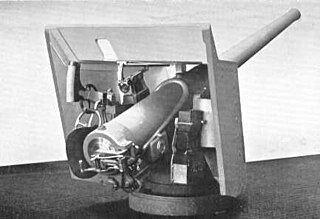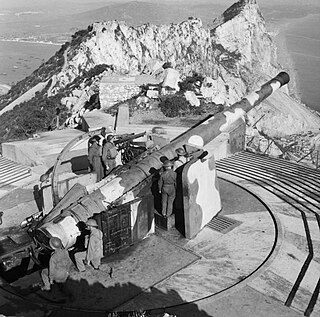Related Research Articles

Coastal artillery is the branch of the armed forces concerned with operating anti-ship artillery or fixed gun batteries in coastal fortifications.

Fort Rodd Hill National Historic Site is a 19th-century coastal artillery fort on the Colwood side of Esquimalt Harbour,. The site is adjacent to Fisgard Lighthouse National Historic Site, the first lighthouse on the west coast of Canada. Both the fort and lighthouse are managed and presented to the public by Parks Canada.

The BL 6-inch gun Mark VII was a British naval gun dating from 1899, which was mounted on a heavy travelling carriage in 1915 for British Army service to become one of the main heavy field guns in the First World War, and also served as one of the main coast defence guns throughout the British Empire until the 1950s.

The QF 4.7-inch Gun Mks I, II, III, and IV were a family of British quick-firing 4.724-inch (120 mm) naval and coast defence guns of the late 1880s and 1890s that served with the navies of various countries. They were also mounted on various wheeled carriages to provide the British Army with a long range gun. They all had a barrel of 40 calibres length.

The following is a List of Coastal Batteries in Australia and Territories during World War II. The main threat came early in the war from German raiders and threat of Japanese raids or invasion, and hence all available ordnance was pressed into service, including some obsolete guns and field guns adapted for coast defence.

The BL 9.2-inch Mk IX and Mk X guns were British breech loading 9.2-inch (234 mm) guns of 46.7 calibre, in service from 1899 to the 1950s as naval and coast defence guns. They had possibly the longest, most varied and successful service history of any British heavy ordnance.


The BL 6-inch Mark XI naval gun was a British 50 calibres high-velocity naval gun which was mounted as primary armament on cruisers and secondary armament on pre-dreadnought battleships from 1906 onwards.

The 11th Coast Regiment, Royal New Zealand Artillery was a territorial coastal artillery regiment of the New Zealand Army based at Godley Head. The regiment was formed in 1940 as 11th Heavy Regiment, New Zealand Artillery and controlled the coastal defence batteries around Lyttleton Harbour. The regiment was progressively expanded and by the end of the war had batteries all over the upper North Island. The regiment was reduced to a cadre in 1957 and disbanded in 1967, along with the other coastal artillery regiments.

The 13th Coast Regiment, New Zealand Artillery was a coastal artillery regiment of the New Zealand Military Forces. It was formed in May 1943 from the coastal defence batteries based in the lower South Island, which were formerly part of 11th Coast Regiment. The regiment consisted of:

Culver Battery is a former coastal artillery battery on Culver Down, on the eastern side of the Isle of Wight, England. The fortification is one of several Palmerston Forts built on the island following concerns about the size and strength of the French Navy in the late 19th century. It was operational during the First and Second World Wars. The battery was closed in 1956.
Barrett Point is located at the foot of Mount Hayes at the entrance to Prince Rupert Harbour at 54°14′28″N130°20′02″W. It was a coastal fortification during World War II.
Wallace Battery was an artillery battery located on the northern side of the entrance to the Hunter River at Stockton, New South Wales, Australia. The battery was part of Fortress Newcastle. Two 6 inch Mk VII guns were installed at Fort Wallace in 1913. In 1940 the 6 inch guns were replaced by two 9.2-inch Mk X guns in emplacements.

St. David's Battery, also known during wartime as the "Examination Battery", was a fixed battery of rifled breech-loader (RBL) artillery guns, built and manned by the Royal Garrison Artillery and the Royal Engineers, and their part-time reserves, the Bermuda Militia Artillery and the Bermuda Volunteer Engineers, part of the Bermuda Garrison of the British Army.

The 2nd Devonshire Artillery Volunteers was a unit of the British Volunteer Force and Territorial Army. The unit and its successors defended Plymouth Dockyard and the Devon coast from 1861 to 1961.

Leighton Battery at Buckland Hill, Mosman Park, Western Australia, was part of the Coastal defences of Australia during World War II and the Fremantle Fortress, protecting Fremantle Harbour.

Challenger Battery, also referred to as J Gun Battery, is a heritage-listed battery at Entrance Point, Garden Island, Western Australia. Historically, it has is also been known as Garden Battery, Entrance Battery and, finally, Challenger Battery. It was added to the Australian Commonwealth Heritage List on 22 June 2004. It was part of the Coastal defences of Australia during World War II and the Fremantle Fortress, protecting Fremantle Harbour.

Fremantle Fortress was the combined coastal defences protecting the harbour of Fremantle, Western Australia, since the mid-1930s and, predominantly, during World War II. The coastal defences of the Fremantle Fortress stretched along the coastline of Perth from Cape Peron to Swanbourne and also included installations on Garden Island and Rottnest Island. While the first coastal batteries of the future Fremantle Fortress were installed at Arthur Head in 1906, the military installations protecting the harbour were expanded in the 1930s, being eventually dismantled again by 1963.

The 10th Coast Regiment, Royal New Zealand Artillery was a territorial coastal artillery regiment of the New Zealand Army. The regiment was formed in 1940 as 10th Heavy Regiment, New Zealand Artillery and controlled the coastal defence batteries around Wellington Harbour. The regiment was progressively expanded and by the end of the war had batteries all over the lower North Island. The regiment was reduced to a cadre in 1957 and disbanded in 1967, along with the other coastal artillery regiments.

The 9th Coast Regiment, Royal New Zealand Artillery was a territorial coastal artillery regiment of the New Zealand Army. The regiment was formed in 1940 as 9th Heavy Regiment, New Zealand Artillery and controlled the coastal defence batteries around Auckland. The regiment was progressively expanded and by the end of the war had batteries all over the upper North Island. The regiment was reduced to a cadre in 1957 and disbanded in 1967, along with the other coastal artillery regiments.
References
- Gamble, Bruce (2006). Darkest Hour: The True Story of Lark Force at Rabaul. St. Paul, Minnesota: Zenith Imprint. ISBN 0-7603-2349-6.